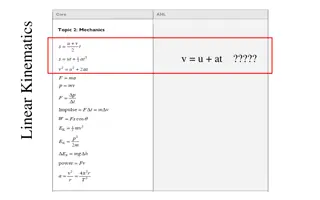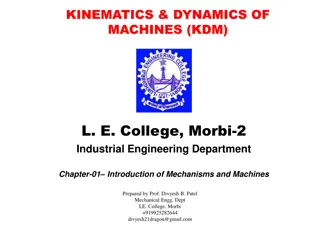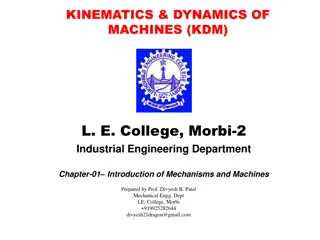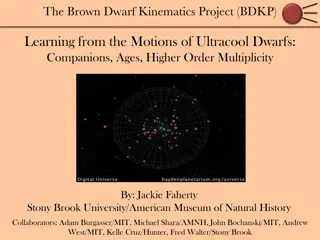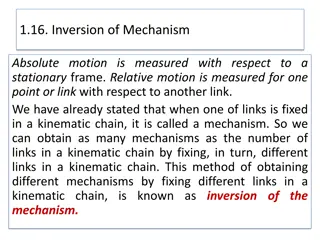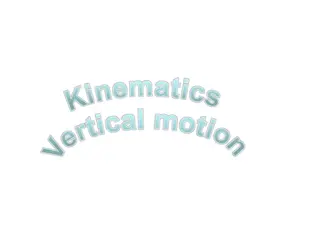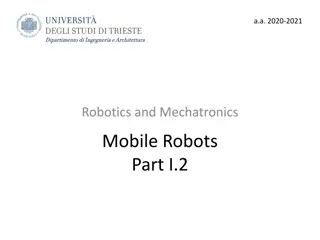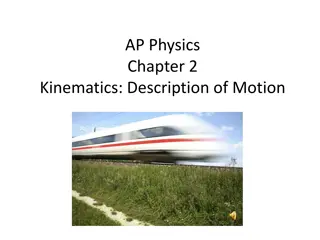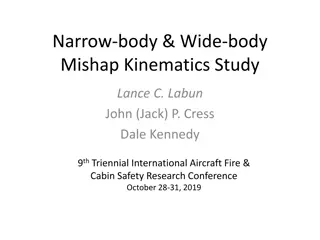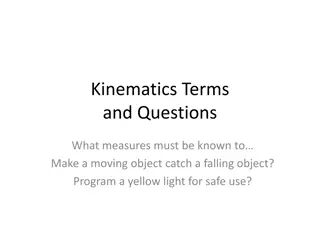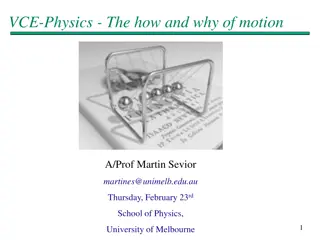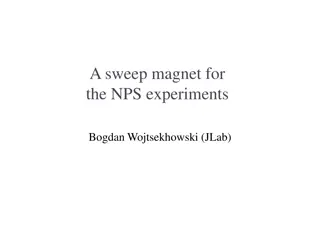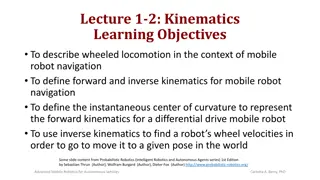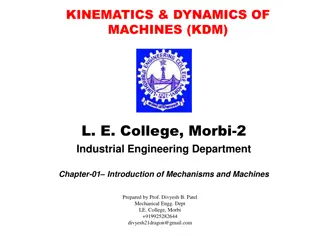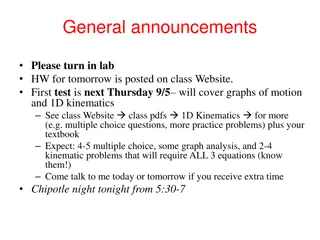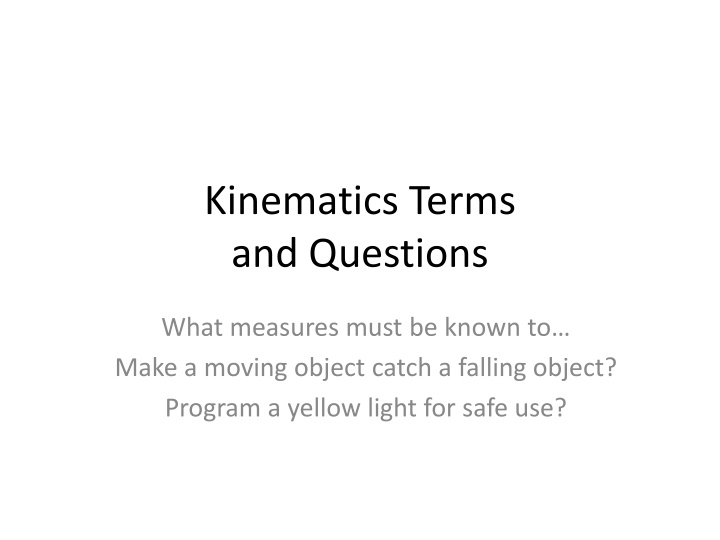
Kinematics: Measures, Formulas, and Problem-Solving
Dive into the world of kinematics with a focus on measures, formulas, and live problems. Explore key concepts such as time vs. duration, position, speed, and velocity to enhance your understanding of motion. Dive into practical applications through lab reports and hands-on experiments.
Download Presentation

Please find below an Image/Link to download the presentation.
The content on the website is provided AS IS for your information and personal use only. It may not be sold, licensed, or shared on other websites without obtaining consent from the author. If you encounter any issues during the download, it is possible that the publisher has removed the file from their server.
You are allowed to download the files provided on this website for personal or commercial use, subject to the condition that they are used lawfully. All files are the property of their respective owners.
The content on the website is provided AS IS for your information and personal use only. It may not be sold, licensed, or shared on other websites without obtaining consent from the author.
E N D
Presentation Transcript
Kinematics Terms and Questions What measures must be known to Make a moving object catch a falling object? Program a yellow light for safe use?
(Your) Kinematics Questions (so far) How fast ? How far ? How long ? Where ? When ?
(Your) Kinematics Questions (after editing) - - - - - - when ? - where ? - how long .? - how far does object move? - how far and which way) is object moved from start? - how fast is object moving? - how fast & which way is it moving? - -
Measurement Names -time -duration -position -distance -displacement -speed -velocity -Which of these terms relates two other terms? - - - - - - -
Kinematics Measures - (t) time -(x,y,z) position - where object is/was -( t) duration - how long does (did) motion take -(d) distance - how far object moves -( x)displacement - how far (and which way) object is moved from start - (S) speed - how fast is object moving -(v) velocity - how fast & which way its moving - when
Using word webs (graphic organizer) for vocabulary Word Webs mimic how your brain works Word Webs can be added to Word Webs take LESS time to write than traditional notes, because you write just what you need Ex: duration (see side board)
Live Problems What is the jeep s speed? Write a lab report on white board. We will race the cars to see if the class s results are accurate. How did we do? How long will it take your jeep to travel 4.0m?
Formulas t = tf to x = xf xo S = d / t v = x / t
Time vs Duration What is the difference? What is the same? Which one must be computed if you use a traditional clock? How do you perform that computation
Distance vs Displacement What is the difference? What is the same? Which measurement matters to a football coach? Which one affects how tired a running back would be at the end of a play? Which one is 1600m when the mile is run at a track meet?
Distance and Displacement During a practice, athletes start at one end of the gym, sprint to the foul line (15 feet), then back to the end-line, then sprint to the mid- court line (42 feet), then back to the initial end-line, then sprint to the other foul line, then back to the initial end-line, then sprint to the opposite end line. Determine the distance and displacement for each athlete. A diagram of the court would be useful!
Speed and Velocity What is the difference? What is the same? What formulas are used? What do you call the value if the speed of the object isn t constant?
Speed vs Velocity Example At a CB South track meet, Riley competes in the 1600m (4 laps of the 400m track). Riley completes the first lap of the race in 60.0 seconds, the second lap in 62.0 seconds, the third lap in 73.0 seconds, and the last lap in 65.0 seconds. In SI units, determine Riley s average speed or average velocity (whichever has relevance in this problem). Now compute the answer in miles per hour.
P.&Q.O.D. Page 32 problem #4 What two pairs of measurements have the same magnitude (numerical value) if, and only if the moving object never reverses direction? If the initial time is zero, what two measurements have the same value? If an object starts at the origin (x=0) what two measurements must have the same magnitude and direction?
The Mathematical Relationship Lab: (how you discover an equation) What is the mathematical relationship between ________________(___) and ___________(__) for ? 1. Devise experiment 2. Perform steps, collecting data 3. Graph Data, determine equation of line or curve. 4. Explain, illustrate relationship. 5. Take a PLQ, using your personal report as a guide during the quiz.
What is the mathematical relationship between ________ (__) and _______ (__) for the jeep (that starts at the origin, and moves slow and steadily in the positive direction)? What (are the best) two kinematics measurements that will fit this question? time, duration, position, distance, displacement, speed, velocity
What is the mathematical relationship between the position (m) and time (s) for a jeep that starts from the origin and moves uniformly in the positive direction? Use a Ticker Tape to determine the jeep s position every tenth of a second for 1.5 seconds Determine the equation that relates position to time for the jeep (while it is in motion). Explain what the equation means. (what it tells you)
What is the mathematical relationship between the position (m) and time (s) for a cart that starts from rest at the origin and goes faster and faster while moving in the positive direction? Use a Ticker Tape to determine the jeep s position every tenth of a second for 1.5 seconds Determine the equation that relates position to time for the jeep (while it is in motion). Explain what the equation means. (what it tells you)
Concluding a Mathematical Relationship Lab: It has been determined that ____(dep)_____ is _______________ to ______(indep)______ (with __ as the exponent), as shown by the equation: This means, if the ______________ is ____________then the ___________ will _______________. For example,
If: x(t) = 3t2+4t-6 1. Where did the object start? 2. What is its average velocity from 2.0s to 4.0s? 3. What is its velocity at 2.0s and 4.0s?
What is the mathematical relationship between the position (m) and time (s) for the jeep while it moves at a constant speed? -The (change of) position of the jeep is directly proportional to (the change of) time, as shown by the equation: x(t) = 0.443t -0.023 -This means that the jeep will change position twice as much in twice the change in time. -For example, if the jeep moved from the origin to position A by time t, then it would move to position 2A by time 2t. This is because the jeep moved with a constant
What is the mathematical relationship between the position (m) and time (s) for the cart that starts from rest and gains speed?
What is the mathematical relationship between the position (m) and time (s) for the cart that starts from rest and gains speed? -The (change of) position of the cart is exponentially proportional to (the change of) time (with an exponent of 2), as shown by the equation: x(t) = 0.1524t2+ 0.04627t -0.002917 -This means that the cart will change position four times as much in twice the change in time (if it starts from rest). -For example, if the cart moved from the origin to position A by time t, then it would move to position 4A by time 2t. This is because the cart .
Post Lab Questions: Which vehicle moved farther in 1.5 seconds? Which vehicle moved faster in the 1.5 seconds?
What will the graph of __________ vs ______________ look like for an object moving at constant speed in positive direction? moving at constant speed in negative direction? speeding up, moving in the positive direction? slowing down, moving in the positive direction? speeding up, moving in the negative direction? slowing down, moving in the positive direction? Note: any changes of speed are to be done with constant acceleration
Post Lab Questions: What does the slope of an x-t graph tell you? What quadrant(s) does a v-t graph need to have? Why? Is the origin shown on a v-t graph? (How, or why not?) What does the slope of a v-t graph tell you? Can you determine position or displacement from a v-t graph? (How?)
POD If x(t) = 3t3-2t + 10 with x in meters and t in seconds, determine a) position at 0.0 and 3.0 seconds b) velocity at 0.0 and 3.0 seconds c) acceleration at 0.0 and 3.0 seconds d) average velocity from 0.0 to 3.0 seconds e) average acceleration from 0.0 to 3.0 sec.
What is the mathematical relationship between Velocity (m/s) and time (s) for a cart , if it starts from rest at x=0.0m at t=0.0s and uniformly speeds up while moving in the positive direction?
How to Get velocity from an x-t graph: 1. Set up Logger Pro and Motion Sensor. Go to: STH Student Shares; Smith_I; STU Share; AP_M; open Position vs Time (BLANK) Hold cart 0.5m from the detector. From the Experiment menu, select zero. Click collect, release the cart about 1 second later. Does the graph look as though your car started from rest at t=0.0s? If not, re-do From the ANALYZE menu, select tangent. Position the cursor at no fewer than 10 times along the curved section. Record these times and velocity values neatly in a table on WB. On your other laptop, open Logger Pro. Manually enter and analyze the data you recorded on whiteboard Prepare for PLQ 2. 3. 4. 5. 6.
Now for something slightly different: What is the mathematical relationship between velocity (m/s) and time (s) for a cart , if it rolls down a hill?
What is the mathematical relationship between the velocity (m/s) and time (s), for a cart if it rolls down a hill?
What is the mathematical relationship between velocity (m/s) and time (s) for a cart , if it rolls down a hill? The cart s velocity is directly proportional to time, as shown by v(t) = 0.1524t + 0.2106. However, since the cart had an initial velocity, by twice the time, it will not have twice the velocity. In twice the duration, the velocity will change twice as much. This means that the rate of change of the velocity (or acceleration) is CONSTANT. For example, If a child on a sled has its velocity change by 2m/s in 5 seconds then it will have its velocity change by 4m/s in 10 seconds.
Lecture: Equations of Constant Acceleration xf- xo= vot + 1/2at2 vf= vo+ at xf-xo= (vo+ vf)t vf2= vo2+ 2a(xf-xo)
Examples CH2 #28, 25, 33, 37, 77

